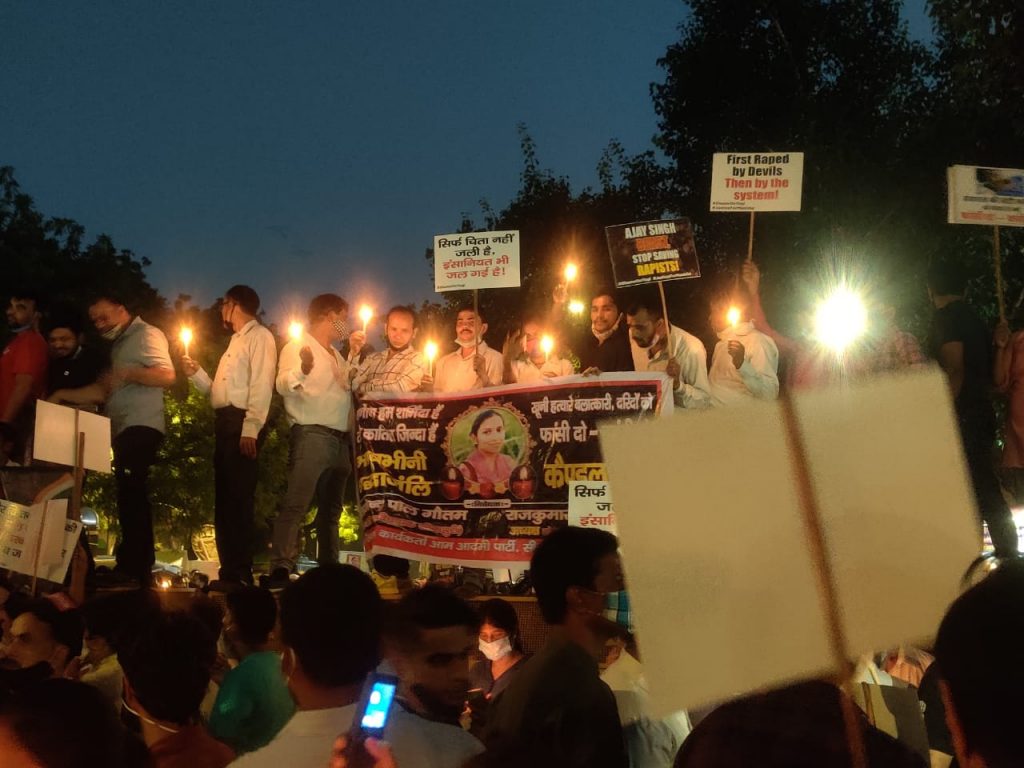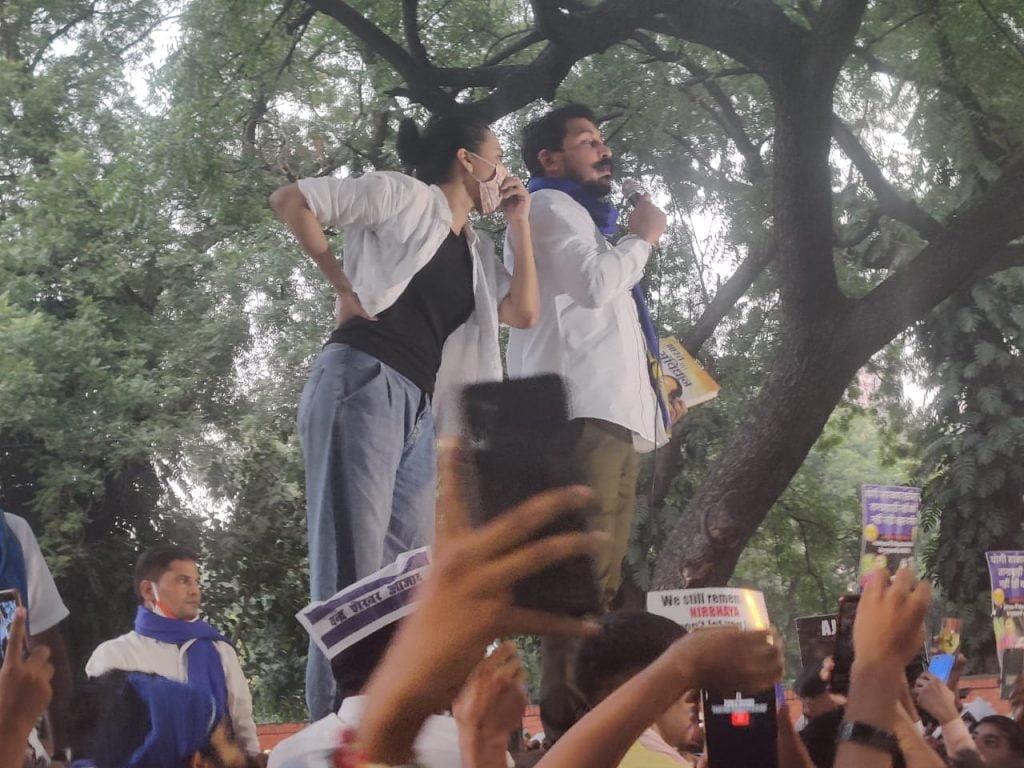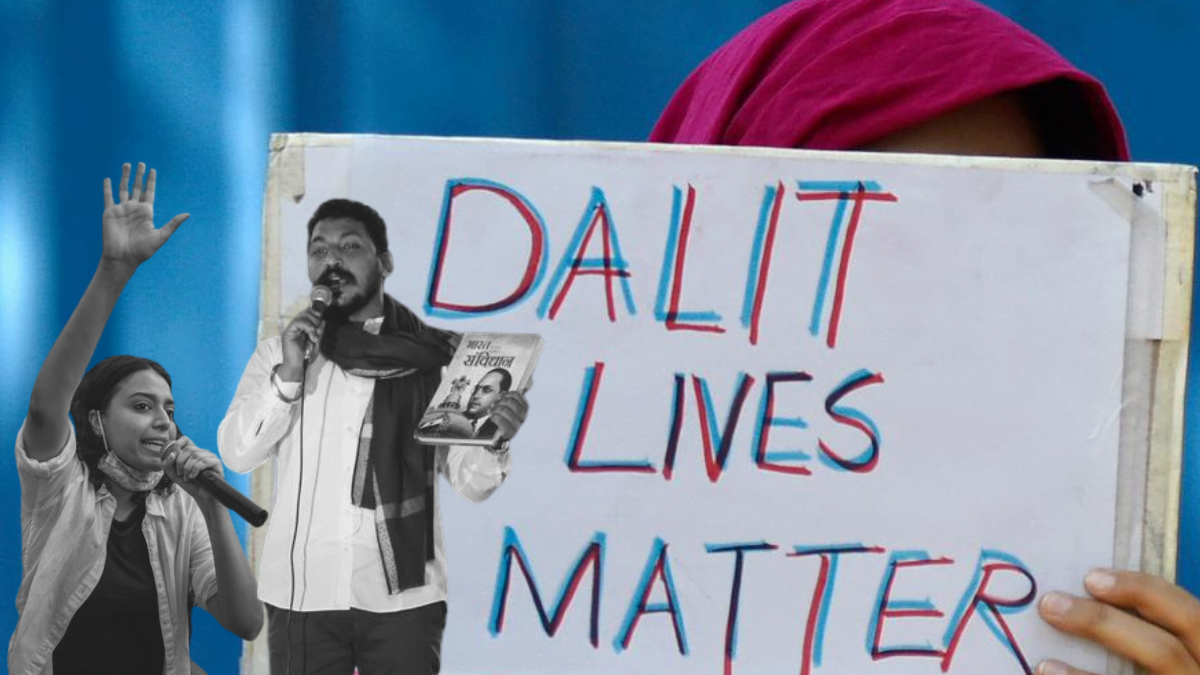Trigger Warning: Caste based sexual violence, Rape, Trauma
As protests unfurl over the Hathras incident, where on 14 September, four dominant Thakur caste men in Uttar Pradesh’s Hathras village gang-raped, brutalised and then strangled a 19-year-old Dalit girl. On 2nd October, various political parties and Dalit right activists called for a protest at India Gate which was later shifted to Jantar Mantar. Attendees of this protest were mostly Dalit men.

It was enraging to see no savarna feminist organisations offering their support. In 2012, post the Nirbhaya case, everybody was out on the streets. As we speak of gendered violence, it is almost impossible to ignore the marginalisation that comes with caste oppression. Feminist organisations’ absence points to hypocrisy among privileged savarna circles.
One of the posters we entered with read, “Dalit Women Educate, Agitate, Organise, REVOLT,” and we were disheartened to see negligible Dalit women. No Dalit woman was made the face of the protest, or even given a platform to speak.
The crimes against Dalit women are part of the broader issue where society fails to recognise it as an issue distinctively linked to caste, and the state machinery (law enforcement) is complicit with the offenders. This is clearly visible with how the Thakurs are receiving support from state machinery, fellow villagers, and Thakur women.
One could distinctively spot two other bizarre protests happening on a day where scores of people had gathered to protest so as to obtain some justice for the Hathras victim.
Walking into Jantar Mantar, we were jarred to hear the slogan, “Bahuon ke dalaalon ko, jootey maaro saalon ko.” Funnily, the “men’s rights activists” found the most unfortunate day to protest against NCW, a day when the brutalisation of the casteist state machinery was visible to all.
In another corner of Jantar Mantar, another protest brewed. Around 40 people came together under the banner of #JusticeForSSR, demanding a fair probe into the death of the late actor Sushant Singh Rajput. “Our protest is planned,” boasted one of them! Fortunately, the protestors against the injustices of the Hathras incident quickly overshadowed both their presence.
When we looked forward towards the protest we came for, it was again a reminder of the savarna, and male brand of exclusion of Dalit women. What this blatantly shines a light on is the way savarna feminists have overlooked the vast atrocities inflicted on women on a regular basis. In addition, the marginalisation by caste and its repercussions for Dalit women are often minimised by such a view.

The crimes against Dalit women are part of the broader issue where society fails to recognise it as an issue distinctively linked to caste, and the state machinery (law enforcement) is complicit with the offenders. This is clearly visible with how the Thakurs are receiving support from state machinery, fellow villagers, and Thakur women. Men like Katju have gone to the length of rape apologia.
Urban upper caste journalists, academicians, and feminist activists have continued to deny caste in their statements. Atishi Marlena, AAP leader, on 2nd October could be heard saying, “We want justice for all women, not just Dalit women.” Although AAP had a few more women supporters to their side as Atishi was one of the woman leaders present, most of them were from dominant castes, and the AAP supporters were not quite intent on addressing casteism as the cause in the crime as it “divides the society into caste.”
“We are here to demand justice for our sisters. We demand that all the culprits should be hung,” said a AAP supporter in the protest.
Such gaslighting by savarna feminists is extremely hypocritical. Swara Bhaskar saw it comfortable to climb on the roof of Bhim Army Chief Chandrashekhar Azad’s car and take up the space which did not belong to either of them, but belonged to a Dalit woman. Swara Bhaskar, a socio-economically privileged savarna woman was offered that space, but not a Dalit woman.

On 3rd October, another protest organised by BAPSA was much more inclusive, really transpiring conversations that one would want to hear. Considerably smaller in number, this candle light march from JNU to a park in Buddh Vihar, had a photo of Babasaheb in the backdrop of candles. One heard Dalit women, a gender non confirming activist, an old Dalit lawyer and the conversations were not reductive to asking for Ajay Bisht’s resignation, or demanding death penalty for the perpetrators.
Also read: 9 Things You Shouldn’t Say To A Survivor Of Sexual Violence
Kaushal Bodwal, a Dalit queer activist was heard saying, “All casteist forces have worked towards establishing that there was no crime. This is not the India that Babasaheb had envisioned. They are letting none of the instruments that were brought by Babasaheb for us, provide us any relief. Death penalty is not the solution for this. We need to attack the Hindu Rashtra at its core, the 4 Thakur men being hanged will make it harder for victims to report in the future, and may end up being used against our men only. We just need to offer each other support, and ensure Babasaheb’s vision is correctly implemented.”

“We need to see how full of lies the foundation of Hindu Rashtra is, where even the family of the victim, that wanted to follow Hindu cremation rituals, were insulted like this. How even those parts of the religion are treated, and we need to at each level try to dismantle casteism, and we need to as a community attack this casteist regime at its core.“
Another BAPSA activist kept her demands in front of the gathering, drawing parallels between what Babasaheb had said, and what is happening today. “What we can see is that Dalits have no place in this country. Dalits are not allowed to share their problems and demands. Why is the establishment scared of us? We want to shame and name the Thakur rapists. In Ram Rajya, As a king, Rama was bound to maintain Chaturvarnya. It was his duty therefore to kill Shambuka, and so is Ajay Bisht. Ajay Bisht is killing the Shambukas, and we want to dismantle this Hindu Rashtra. We are children of Ambedkar, we do not want your Hindu Rashtra, we want his dream of a Prabuddha Bharat!,” she roared.
Urban upper caste journalists, academicians, and feminist activists have continued to deny caste in their statements. Atishi Marlena, AAP leader, on 2nd October could be heard saying, “We want justice for all women, not just Dalit women.”
There was no man arriving in his signature style, hogging up the space for Dalit women.
The Problems
Over the years, with the way the feminist movements have progressed, we have theoretically understood the overlapping systems of caste, class, sexuality, physical and mental disability, ethnicity. Unfortunately, the ground reality is evidently such that we are miles away from where we need to be. When one raises their voices against injustice, and slogans such as “hang the rapists!” are heard, it’s awfully self-defeating, because excessive research has shown that the death penalty is reductive to survivors, and in fact harms socio-economically underprivileged more than it benefits them.
When we do analyse the way the protest on Jantar Mantar on 2nd October was conducted we find an abject lack of sensitivity for Dalit women’s issues. Is it just one sexual violence incident that we want to address? No. The sense of asking a Dalit woman to lead the protest against injustices towards Dalit women is obvious, and nobody should have had to point this out, especially to our own leaders.
When questioned, an internal patriarchy was observed in the Dalit men, Bhim Army volunteers were all very reluctant to answer, and kept diverting the point. They also stated offensive answers such as, “How do you think a woman would have managed to climb on the roof of the car like that?” Or “My wife is leading a protest back home, she is with the children.” “Dalit women have a lot of work back home, they cannot afford to come to a protest with us.” Having such thoughts over matters of gendered representation and justice, how can we expect them to ask for justice for Dalit women?
What needs to be addressed are systemic discriminations that need to be resolved. The SC/ST (prevention of atrocities) Act is in effect to shield Dalits and prevent such atrocities. Problems stem where this act is concerned; the act is drafted in a manner that it makes a provision for the prevention of atrocity. However, this Act is only used when the atrocity has already been committed. This is what happens in majority cases and the same has happened in the Hathras case. The upper caste law enforcement and upper caste courts have made the act obsolete.
In 2019, 100 cases of caste-based atrocities on Dalit women, girls, a total system breakdown was observed. These were taken up by Dalit Women Fight. In 99 percent of these instances, instead of the First Information Report (FIR), an acknowledgment for a Non-Cognizable crime was handed out by the police. Any atrocity against a person from a marginalised caste is to be reported under SC/ST atrocity act, and not just say, POCSO or women’s safety.
We need to address systemic failures and why there are not enough women, especially Dalit women, sitting in positions of power. Right now, the entire energy is being invested in somehow providing impunity to the Thakur perpetrators, right from caste dominated media houses to the savarna parishad actively fighting for the Thakurs. Yet again, islamophobia has been dragged into the case somehow. Brahminical patriarchy works like this, with absolute impunity. One cannot completely defeat the systems in play here just by defeating BJP, we have to dismantle Brahmanical patriarchy.
This starts at home, where savarnas talk to their families and friends and actively influence people to acknowledge their privilege and really start making efforts to unlearn casteist bias. This starts by offering representation to Dalit women, queer individuals, and holding our leaders accountable.
This starts by questioning spaces like newsrooms, where unfortunately till today we do not have representation. Less than 5% Dalits are part of newsrooms, and more often than not they receive the treatment that Prashant Kannojia is receiving. Of course Anjana Om Kashyap will continue to label us “dangais” and Arnab Goswami will gaslight our truths, their lived experiences dictate them to reduce the causes of Dalits to mere headlines, and never take action on them.
Also read: The Problem With Re-enacting Sexual Violence Against Women On TV
It is absolutely imperative that the progressive and leftist feminists of the upper class, upper caste, see the involvement of caste in crime and stand in unity with the Dalit women—the way Dalit women have stood with them. Intersectional feminism asks us to do this. Its main aim is to deconstruct, decoding and analysing the interactions created and conditioned by one’s identity and filling the gaps that remain—to create a culture that is welcoming, inclusive and accessible for all individuals.
Suchitra is a journalism and mass communication student who loves to write and read. Poetry, music, politically correct humour and smashing Brahminical patriarchy are her major interests. You can find her on Facebook, Instagram and Twitter.
Anjali Rai is a Dalit Feminist, currently working in National Campaign on Dalit Human Rights, who is very vocal on forums about anti-caste issues and feminist issues.
All pictures have been provided by Suchitra.





You say Dalit women should be leading the protest. This is a point well-taken. But it is not enough. Should you not be saying poor Dalit rural women? Could a bourgeois Dalit woman lead the protest. If a bourgeois Dalit woman replaced Swara Bhasker and Chandrasekar Azad, would she be a true representative of a poor rural Dalit woman. Would not a bourgeois Dalit woman like Yashica Dutt be closer to Swara Bhasker in her thinking than a poor rural Dalit woman? How can she stand in for all the poor rural Dalit women according to your own logic of identity? This is the problem with thinking intersectionally. It essentialises categories of identity and makes solidarity across identities impossible.